|
Formulation
and Validation of a Cell-Responsive Peptide Linker for Nucleic Acid
Delivery
Jennifer Devaney, Peter G. Millili, John D. Larsen, Millicent O. Sullivan Department of Chemical Engineering Research into non-viral gene
delivery seeks a vehicle to protect and transport genetic material to
specific physiological and cellular locations within the body. This
involves a material capable of meeting the contradictory requirements
of shielding its cargo from nucleases in the blood stream and yet be
able to efficiently release the genetic material at the site of
action. To meet these demands, we aim to create a cell responsive
peptide linker to bind poly(ethylene glycol) (PEG) to the delivery
vehicle surface. The PEG layer allows the resulting particle to resist
immune recognition and colloidal aggregation through steric hindrance.
However, these same characteristics also reduce interactions with
cells. To overcome this, a matrix metaloprotease-1 (MMP-1) cleavable
peptide sequence will be used to attach the PEG to the delivery vehicle
surface . This will allow the PEG to be cleaved off in close
proximity to tumor cells, as these cells upregulate MMP-1 to remodel
the extracellular matrix. In this work, peptide-PEG conjugation
has been investigated using reverse phase high performance liquid
chromatography (RP-HPLC). Furthermore, the cleavability of this
peptide by MMP-1 and inhibition of this cleavage reaction by EDTA has
been demonstrated. Confirmation of this conjugation and cleavage
reaction will enable inclusion of this linker in future DNA delivery
vehicles. This research has been funded by the Department of
Chemical Engineering.
|
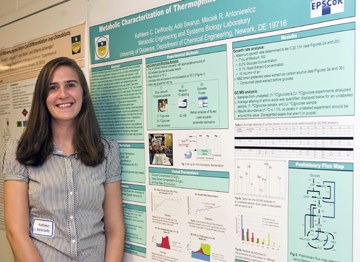 Metabolic Characterization of Thermophilic Bacteria in Batch Culture Kathleen C. DeWoody, Aditi Swarup, Maciek R. Antoniewicz Department of Chemical Engineering Thermophilic bacteria have
unique properties that make them ideal candidates for biotechnological
applications. However, due to our limited understanding of their
metabolic capabilities their potential has not been fully explored. In
this research, a newly discovered strain of thermophilic bacteria was
characterized. The growth patterns, optimal growth conditions,
and metabolic fluxes were studied in order to elucidate pathways active
during cell growth. Cells were cultured at 75˚C in mini-bioreactors
with a working volume of 7 mL. The complex growth medium contained 0.2%
glucose and 0.1% yeast extract. The maximum growth rate was determined
from analysis of carbon dioxide evolution rate in the off-gas, and was
found to be 0.22 1/hr. To study intracellular metabolism, cells were
cultured with [U-13C]glucose and [1-13C]glucose as isotopic tracers.
Hydrolyzed biomass was analyzed using gas chromatography/mass
spectrometry (GC/MS) in order to establish the carbon labeling trends
associated with each amino acid synthesized during growth. A
previously established E. coli network model was used as a template for
the analysis of the data from the new strain using the software Metran
to determine metabolic fluxes. A detailed flux map for the central
metabolism was established. Future work aims to characterize the
complete metabolic network for this bacterium using additional
information from genome sequencing and annotation. Results from this
work will lead to the development of novel approaches for engineering
thermophilic bacteria for biotechnological applications. Funding for
this project was provided by NSF EPSCoR.
|
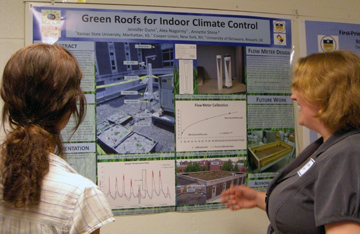 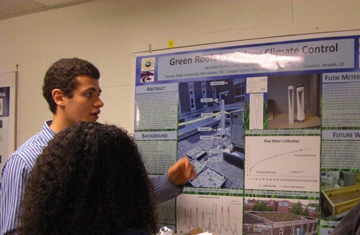 Green Roof for Climate Control Jennifer L. Dunn1, Alex Nagorniy2, and Annette D. Shine 1Kansas State University Chemical Engineering Department, 2Cooper Union Chemical Engineering Department Green roofs are becoming a more
environmentally friendly method for climate control, specifically
cooling. A green roof has been proposed to cool the first floor
wing of Colburn Laboratory because the underlying classrooms become
excessively hot during the winter months. The green roofs plants
and soil media will insulate the roof from incoming solar radiation and
cool the roof by evapotranspiration. A monitoring station has
been ordered to gather meteorological data and a triangular weir flow
meter has been designed to monitor water runoff from the roof.
This equipment has been installed on a pilot green roof. These
data will eventually be used to calculate the thermal capacity of the
soil and evaluate the cooling effectiveness of the green roof.
|
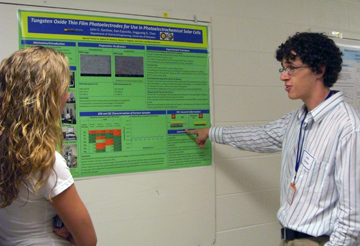 Tungsten Oxide Thin Film Photoelectrodes for Use in Photoelectrochemical Solar Cells John C. Gardner, Dan Esposito, and Jingguang G. Chen Institute of Energy Conversion Tungsten oxide photoelectrodes
made with a tungsten foil substrate were constructed using the methods
of electrochemical deposition and physical vapor deposition. With
the electrochemical deposition, the solution components, gases present,
and film thickness or deposition time were changed in an attempt to
optimize the optical properties of the film. In the same manner,
the partial pressure of oxygen gas present, substrate temperature, and
film thickness or deposition time were changed to optimize the physical
vapor deposition process. Numerous characterization techniques
including UV-Vis, X-ray diffraction (XRD), X-ray photoelectron
spectroscopy (XPS), Quantum Efficiency (QE), and cyclic voltammetry
(CV) were used to analyze the electrodes produced by the different
methods at various parameters. In particular, the QE system was
used extensively, and for each measurement, a novel liquid electrolyte
solar cell set-up was constructed and analyzed. This research
focused not only on comparing different deposition techniques and
optimizing them, but on the equipment used to analyze each cell.
|
|
Phase behavior study of crystallizing surfactant
solutions
Anne Golematis, Norman J Wagner, Prachi Thareja, and Carrie Street Department of Chemical Engineering We present the case study of an
industrial skin-care cream. A variety of skin-care creams are complex
systems whose behavior under flow directly affects their tactile
properties or their sensory perception. The goal of this research is to
study the phase behavior of a skin cream formulation, which is
essentially a mixture of surfactants in water. The components are
Sodium Dodecyl Sulfate(SDS), Tegobetaine, Palmitic acid(PA), and water.
Palmitic acid is known to exist as crystals at room temperature and is
therefore expected to affect the macroscopic properties of the cream
formulation. The phase behavior of various
surfactant formulations in water were studied, to find a region of
composition where the formulation exists as one phase. Pseudo ternary
phase diagrams were constructed at different temperatures to show the
one or two phase regions containing various palmitic acid crystal
morphologies. The one phase region is of most practical
interest and depending on the surfactant compositions, the
microstructure will correlate with the observed macroscopic
properties. Research funded by: Unilever and The University of
Delaware’s Undergraduate Research Program.
|
|
The
Application of Tandem Mass Spectrometry to Metabolic Flux Analysis
Matt Grossbach, Jungik Choi, and Maciek R. Antoniewicz Department of Chemical Engineering Metabolic flux analysis (MFA) has become a key concern in biotechnology and medicine. Metabolic fluxes describe what the cell does and, as such, provide an informative description of the overall cellular physiology. Stable-isotope MFA is the most comprehensive and effective means of characterizing metabolic fluxes in vivo. In this project, we applied a novel analytical technique, tandem mass spectrometry (GC-MS/MS), to quantify isotopic labeling distributions of glucose and amino acids to study metabolic fluxes. Specifically, we quantified stable-isotope labeling (13C and 2H) by GC-MS/MS in order to better identify the position of labeled atoms and increase the number of independent measurements. Using linear mapping techniques, we constructed isotopomer coefficient matrices from which the number of independent measurements for particular parent ions and amino acids were determined. These independent measurements could be used to estimate metabolic flux rates from labeling experiments. We started by analyzing 11 amino acids previously determined to be useful and identifiable. Then, having well-established methodology and analytical procedure, we moved to examine glucose labeling. We validated our techniques with labeled standards and applied these methods to analyze samples collected from tracer experiments with rat hepatocytes (i.e., liver cells). It is believed that by being able to more accurately measure and observe hepatocyte pathways, we will eventually be able to understand more about metabolic diseases such as type II diabetes. This project was funded by the University of Delaware's Science Scholars Program. |
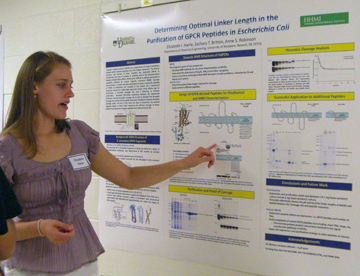 Determining Optimal Linker Length in the Purification of GPCR Peptides from Escherichia coli Elizabeth I. Hanle, Zachary T. Britton and Anne S. Robinson Department of Chemical Engineering G-protein coupled receptors (GPCRs) are a large family of integral membrane proteins which mediate signaling across the cellular membrane. The diverse structure and function of these receptors has motivated efforts to characterize this class of proteins in academia and in the pharmaceutical industry. Despite these efforts, GPCRs prove difficult to express and purify in quantities sufficient for structure determination. A system has been developed to express and purify peptides of GPCRs in Escherichia coli for nuclear magnetic resonance (NMR). Included in this system are a ketosteroid isomerase domain to enable high expression, Strep affinity tags for purification, a thrombin cleavage site, and a 6xHis-tag to facilitate purification. Repeated GSG-linker sequences between the ketosteroid isomerase and the thrombin cleavage site as well as between the thrombin cleavage site and the GPCR peptide have been included to improve thrombin cleavage yields. The aim of this work has been to determine the minimal required length of these linker sequences for efficient cleavage of fusion protein from the adenosine receptor peptides hA1R 260 and hA2aR 259. |
|
First-Principle
Calculations of Adsorbate-Metal Interactions for Catalyst Design
Stanley Herrmann, Giannis Mpourmpakis and Dionisios G. Vlachos Department of Chemical Engineering The metal-adsorbate bond
formation is a fundamental step in catalysis that controls activity and
selectivity. By tailoring the strength of this bond, one can
control catalyst performance. A possible way to do this is to use
novel metals as catalysts. Herein, density functional theory
(DFT) was employed to determine the binding energy of several
adsorbates participating in the water-gas shift reaction (H, O, C, CO,
OH) on 10-atom metal clusters. The d9 (Cu, Ag, Au) pure metals
and their bimetallic combinations (CuAg, CuAu, AgCu, AgAu, AuCu, AuAg)
were used. A novel optimization scheme was applied to allow a
small cluster to mimic the properties of the bulk metal
structure. We investigated the H and C interaction on a hollow
site of the metal; the O and OH interaction on the bridge site; and the
CO interaction on the top site. We used spin unrestricted
calculations and we accounted for a series of different spin
multiplicities. A database of binding energy values was
constructed. On top of this, the effect of bimetallic catalyst
selection on the adsorbate binding energy was explored and trends among
metals were extracted that can be used toward catalyst design.
Funding for this research was provided by Delaware’s NSF ESPCoR Program.
|
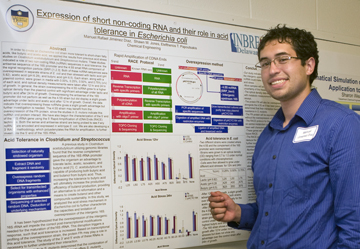 Expression of short non-coding RNA and their role in acid tolerance in Escherichia coli (First place McNair Research Award) Manuel R. Jimenez1, Shawn W. Jones, and Eleftherios T. Papoutsakis 1Northwestern University In order to create an Escherichia coli strain more
tolerant to short-chain fatty acids, like butyric and acetic acid, we
applied the results from previous acid stress studies on Clostridium acetobutylicum and Streptococcus mutans. These studies
indicated a role of two non-coding RNA (ncRNA) sequences in acid
tolerance: the antisense sequence of the 16S promoter and the 4.5S
small RNA component of the signal recognition particle (SRP). Both of
these ncRNA sequences were overexpressed in separate strains of E. coli and then stressed with
lactic acid (pH 5.82), acetic acid (pH 6.28), and butyric acid (pH
6.5). Each strain, along with a plasmid control, were grown in media
with 0.00%, 0.25%, 0.50%, and 0.75% (v/v) of each acid, and optical
density measurements were taken after 12 hr and 24 hr of growth. In
general, the strain overexpressing the 4.5S ncRNA grew to a higher
optical density than the plasmid control with significant advantage
under lactic and butyric acid after 24 hr of growth. Overexpressing the
antisense of the 16S promoter did not perform as well as the 4.5S
strain but did display a slight growth advantage under lactic and
acetic acid after 12 hr of growth. Overall, the data indicate that
overexpressing these ncRNAs gives a slight growth advantage but further
investigation is needed. The 4.5S strain may benefit from the
overexpression of the Ffh protein, since the studies in Streptococcus
mutans indicate this ncRNA and protein interact. We have also begun the
characterization of the 5’ end of the 16S rRNA gene using the 5’ Rapid
Amplification of cDNA Ends (RACE) technique. Both the sense and
antisense strand are being probed to see if any ncRNAs are encoded and
expressed in wild-type E. coli.
We are also developing a 3’ RACE methodology, which polyadenylates the
RNA for amplification, to further investigate the 5’ end of the 16S
rRNA.
|
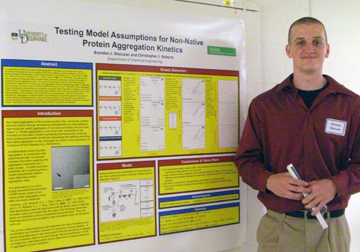 Testing Model Assumptions for Non-Native Protein Aggregation Kinetics Brendan J. MacLean and Christopher J. Roberts Department of Chemical Engineering A mathematical model of
non-native protein aggregation is developed and analyzed that
explicitly accounts for the dynamics of pre-nucleation which were
neglected in earlier generations of the Lumry-Eyring
Nucleated-Polymerization (LENP) model (Andrews, J.M.; Roberts,
C.J. J. Phys. Chem. B 2007, 111, 7897-7913 and Li, Yi; Roberts,
C.J. J. Phys. Chem. B 2009, 113, 7020-7032). The new model
is able to capture an expanded range of experimentally observable
behaviors, in terms of the kinetics of monomer loss and aggregate
growth. The model is first solved for cases in which
folding-unfolding equilibration is assumed to be much faster than
aggregation rates and aggregate-aggregate condensation does not
occur. As a result, only two limiting kinetic behaviors are
found: association-limited aggregation, where dimerization is
rate limiting; and nucleation-and-growth limited aggregation, analogous
to the earlier LENP models. A global search of parameter
space indicates that for most experimentally relevant cases,
self-association or pre-nucleation can be assumed to be
pre-equilibrated. Although experimental examples for aggregation
in which association may realistically be rate-limiting appear to be
scarce, the current model is sufficiently general to hold under these
conditions. Ongoing efforts and preliminary results are directed
at testing the assumption of pre-equilibrated folding-unfolding
transitions in the LENP model. Funding from the Howard Hughes
Medical Institute is gratefully acknowledged.
|
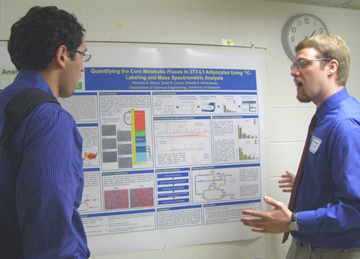 Quantifying the core metabolic fluxes in 3T3-L1 adipocytes using 13C-labeling and mass spectrometric analysis Nicholas A. Marze, Scott B. Crown, and Maciek R. Antoniewicz Department of Chemical Engineering Obesity is a growing health
epidemic in the United States and around the world, but the metabolic
mechanisms that affect fat storage and lead to obesity are poorly
understood. In this project, we studied adipocyte
metabolism using the 3T3-L1 cell line as an in vitro model for white
adipose tissue, the predominant type of fat tissue in humans. We
successfully differentiated these cells from their native fibroblast
phenotype to an adipocyte phenotype, which we verified via lipid
staining. We introduced carbon-13-labeled tracers, namely
[U-13C6]glucose and [U-13C5]glutamine, to the adipocytes. After
the cells were given time to metabolize the tracers, key intracellular
metabolites (citric acid cycle intermediates, amino acids, and
palmitate) were extracted, TBDMS-derivatized, and analyzed using gas
chromatography/mass spectrometry (GC/MS). Metabolites that
incorporate carbon-13 from the tracers show characteristic peaks in the
mass spectra at higher masses. With a computer program (Metran), we can
use the relative peak heights (the mass isotopomer distribution) to
quantify the flow of carbon atoms through the cells’ metabolic
pathways. Our analysis is still pending, but we expect to be able
to assign relative fluxes to each reaction in the citric acid cycle and
to a number of anaplerotic reactions of importance to in vivo palmitate
biosynthesis. From these numeric fluxes, we will be able to see
which and to what extent metabolic pathways are active in white
adipocytes. This project was funded by the University of
Delaware's HHMI Undergraduate Science Education Program.
|
|
Development
of a Peptide Nucleic Acid Based siRNA Delivery System
Tejal U. Naik, Abbygail A. A. Palmer, Peter G. Millili, Millicent O. Sullivan Department of Chemical Engineering Small interfering RNA (siRNA)
is a double stranded RNA molecule that has a major role in gene
silencing by splicing the mRNA of a gene of interest, thus inhibiting
expression. The ability to harness the therapeutic benefit of
siRNA can have a widespread impact on a variety of therapies ranging
from cancer to HIV. However, the efficacy of such treatments is
limited due to the many extracellular and intracellular barriers
associated with delivery. One approach, involving siRNA
functionalized surfaces, can improve the cellular response and
specificity by creating a tunable release system. In this work, we
propose the utilization of a peptide nucleic acid based siRNA
surface-mediated delivery system. Peptide nucleic acids are
nucleic acid analogs that hybridize with complementary DNA or RNA
sequences, enabling direct attachment of various macromolecules such as
peptides. Conjugation of targeting and protective moieties can
potentially enhance the delivery of siRNA. In order to test this,
a cell transfection model utilizing stably transfected B16FO mouse
melanoma cells (producing Green Fluorescent Protein (GFP)) was
established. Anti-GFP siRNA was designed and its efficacy was
evaluated via Flow Cytometry and fluorescence microscopy.
Optimization of cell seeding density, siRNA concentration, use of
antibiotics, and time of transfections was accomplished, effectively
demonstrating gene silencing capability. In preparation for
future siRNA modifications, peptide nucleic acid-peptide conjugates
were purified through Reverse Phase High Performance Liquid
Chromatography (RP-HPLC). Development of various chemical
linkages and optimization of a cell transfection model lay the
groundwork for future development of this nucleic acid delivery system.
|
 Synthesis and Characterization of Iron Platinum Nanoparticles in a Boron Nitride Matrix Matt Oleksiak, G. Hassnain Jaffari, and S. Ismat Shah Material Science and Engineering The trend towards smaller
electronic devices over the past decade demands for the development of
ultrahigh-density recording media. Such developments require decrease
in particle size; however this is hindered by the superparamagnetic
limit. Iron Platinum (FePt) is one of the most promising candidates
since it has the highest anisotropy constant measured in magnetic
systems. This lower anisotropy constant can be used to push the
superparamagnetic limit to even lower dimensions. We are planning to
synthesize FePt particles using magnetron sputtering inside a Boron
Nitride (BN) matrix, which will allow us to post anneal samples in
order to attain L10 phase while avoiding agglomeration. To assist
in achieving this effect we will cool the substrate with liquid
nitrogen while depositing FePt in order to maintain the separation of
particles. These particles will be characterized using transmission
electron microscopy and vibrating sample magnetometery.
|
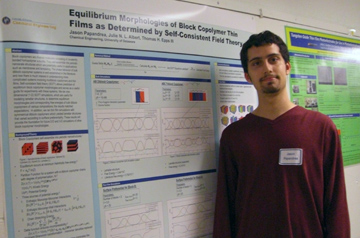 Equilibrium Morphologies of Block Copolymer Thin Films as Determined by Self-Consistent Field Theory. Jason Papandrea, Julie N. L. Albert, and Thomas H. Epps, III Department of Chemical Engineering Block copolymers are chained
molecules consisting of covalently bonded homopolymer subunits. They
self-assemble into periodic nanoscale structures which are potentially
useful in applications such as membranes and templating. The phase
behavior of bulk diblock copolymer systems is well-established in the
literature, and now there is much interest in understanding more
complicated systems involving multiblock copolymers and thin films.
Self-consistent field theory (SCFT) allows prediction of equilibrium
block copolymer morphologies and serves as a useful guide for
experiments with these systems. We ran one-dimensional (1-D) SCFT
simulations, which are useful for modeling lamellar structures, to
determine equilibrium morphologies and corresponding free energies of
bulk diblock copolymers of various compositions; the results matched
expectations. In addition, we ran thin film simulations with
symmetrical diblock copolymers which yielded lamellar structures that
varied according to surface preferentiality. These results will provide
the foundation for future 2-D and 3-D simulations of other block
copolymer morphologies.
|
|
Using
Zeolite-L for the Production of Dye Sensitized Photoluminescent Solar
Concentrators
Tracy L. Powell, Raul Lobo, and Dustin Fickel Department of Chemical Engineering The ability to harness sunlight
for energy production provides an alternative energy source which is
both renewable and adaptable. The most common solar cells on today's
market operate off of the semi-conductive properties of doped silicon
wafers which, due to the high cost of production, cannot compete with
coal or natural gas. The goal of this project was to produce a less
expensive, yet efficient, photoluminescent solar concentrator using the
structural properties of zeolite-L, a nanoporous crystalline material,
in combination with fluorescent dye molecules for the collection and
use of electromagnetic radiation. In the end, the solar concentrator
will be coupled to a traditional (but smaller) solar cell. The
dyes, 4-dimethylamino-4'-nitrostilbene and nile red, were selected due
to their size (they fit in the zeolite) and minimal overlap of
absorption and emission wavelengths, and were incorporated into the
pores of the zeolite which serves to align the dye molecules and ensure
efficient capture of emitted photons. Dye loaded zeolite-L was
suspended in a polymethylmethacrylate-toluene solution and then
spin-coated onto a square inch glass slide. Due to the structure of the
zeolite platelets, the pores of the zeolite should align and direct the
photons to the edges of the cell where they can be collected. Testing
of the device is in progress. This work was funded by Delaware's
Science and Engineering Scholars Program.
|
|
Mathematical Modeling of Mesenchymal Stem Cell
Differentiation Into Osteoblasts
Sven A. Saldanha, Prasad S. Dhurjati, Anja Nohe, and Gilberto Schleiniger Departments of Chemical Engineering, Biological Sciences, and Mathematical Sciences According to NIH, 10 million
Americans have osteoporosis and an additional 34 million are at high
risk with low bone density. Osteoporosis is caused by an
imbalance of osteoclasts, which break down bone, and osteoblasts, which
are responsible for bone formation. Research has shown that BMP-2
(bone morphogenetic protein) stimulation of the stem cell line C2C12,
mouse myoblast cells, results in differentiation into osteoblasts,
adipocytes, and myotubes dependent on the concentration of the ligand
present in the serum. This complicates matters as selective
differentiation is highly favored for treatment of low bone
density. Additionally, the formation of other cells, for example
adipocytes (fat cells), can actually be problematic as research has
shown that fat cells have a detrimental effect upon osteoporosis. The
current project seeks to determine the mechanism of mesenchymal stem
cells differentiation. To gain insight into the mechanism
responsible for the differentiation process, a differential equation
based mathematical model has been developed. This mathematical
model primarily considers the activation of the SMAD signaling pathway
upon stimulation with BMP-2 and resulting osteoblast
differentiation. This project was funded by the University of
Delaware Science and Engineering Scholars Undergraduate Research
Program.
|
 Mathematical Simulation of Drug Concentration in the Human Body: Application to Nanomedicine and Pediatrics (Recieved third place in Sigma Xi competition.) Sharon Weaver, Prasad Dhurjati, and Anja Nohe Departments of Chemical Engineering and Biological Sciences The knowledge of the
concentration of a drug in the internal organs of the human body is
crucial in ensuring its maximum efficacy. The goal of the project is to
estimate the concentration of drugs in different organs using a
mathematical model. The major tasks included the creation and
modification of a mathematical model of the human body. The starting
point for the research was a model developed by Bischoff. The
model can be used for calculating the concentration of
methotrexate (a cancer drug), in the blood, liver, kidney, muscle and
gut of four different animals: rats, mice, dogs and humans. The model
equations were coded in MATLAB and the previous simulation results were
validated. The model was then modified for two new applications. The
first model modification was to show how methotrexate concentration
differs in children and adults. Work was done to adjust the volume and
blood flow rates to discover why children have more severe side effects
when administered methotrexate. The second application deals with
target-specific drugs, where a nanoparticle can be directed to
accumulate in specific organs based upon charge and size. Initial
graphs were made to model how the charge of a drug administered
intravenously affects the concentration of the drug in various organs.
Further research will allow for the addition of drug size as well as
expanding the model to include additional organs. The results of
the modified models will have important implications for the design and
delivery of pediatric drugs and nanomedicine. This project was funded
by Howard Hughes Medical Institute.
|
|
The Electrochemical Properties of Tungsten
Monocarbide (WC) Over Wide pH and Potential Ranges
Mark Weidman, Dan Esposito, and Jingguang G. Chen Department of Chemical Engineering Tungesten Monocarbide (WC) has
been shown to exhibit catalytic properties similar to those of Platinum
(Pt). Due to the limited supply and high cost of Pt, WC has
attracted interest for its potential application as a catalyst for the
hydrogen oxidation reaction and methanol oxidation reaction in fuel
cells. Thin foils made of Tungsten (W), WC, and Pt were studied
in an electrochemical cell to determine their stability and activity
over a wide range of pH values. WC thin films were synthesized on
polycrystalline W foil substrates via physical vapor deposition (PVD)
or in a furnace in the presence of methane. Cyclic voltammetry
(CV), chronoamperometry (CA), chronopotentiometry (CP), and linear
scans (LS) were used to measure the electrochemical properties of the
foils in electrolytes of varying pH. X-ray photoelectron
spectroscopy (XPS) and x-ray diffraction (XRD) confirmed the surface
and bulk compositions, respectively. WC was able to catalyze the
hydrogen evolution reaction at lower overpotentials than W. WC
also showed a greater resistance to surface oxidation than W.
While W and WC behaved similarly at low pHs, their behavior diverged at
higher pHs as a result of different surface oxide formation and
different solubility of these oxides. Funding is provided by the
Department of Energy and the University of Delaware’s Undergraduate
Research Program.
|
|
Altering
Recombinant Protein Production Using RNA Interference
Jinming Xing1, Stephanie Hammond2, and Kelvin Lee2 1Delaware Technical & Community College, 2Delaware Biotechnology Institute Mammalian cells are widely used
to produce recombinant therapeutic proteins. In a previous study of
Chinese hamster ovary (CHO) cells producing secreted alkaline
phosphatase (SEAP), several proteins showed altered expression in a
high-producing cell line. Cofilin, a key regulator of actin
cytoskeleton dynamics in mammalian cells, was down-regulated in a
high-producing cell line. Here, RNA interference is used to decrease
cofilin levels, aiming to improve SEAP secretion. Previous experiments
showed a 50% transient knock-down of cofilin by short interfering RNA
(siRNA) along with 40% increase in SEAP production. To generate
long-term knock-down of cofilin, short hairpin RNA (shRNA) vectors
targeting the cofilin gene were made and transfected into CHO-SEAP
cells. The knock-down of cofilin was determined by western
blotting while SEAP production was measured using a SEAP activity
assay. Preliminary results show a 25% knock-down of cofilin by
shRNA and a 20% increase of SEAP production. These results
suggest that these shRNA vectors may be used to generate stable cell
lines with reduced cofilin levels and enhanced SEAP production.
This project was supported by Grant No. 2P20RR016472-09 under the INBRE
Program of the National Center for Research Resources (NCRR), a
component of the National Institutes of Health (NIH), and Genentech.
|